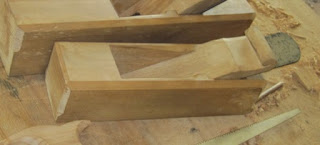If you've read my "About Me" section you know that my background consists of working with my dad in his machine shop, supervising a museum blacksmith shop, and spending some time living and studying with Japanese swordsmith Shoji Yoshihara. My real experiences are in metal working, but when I applied to Williamsburg, I stated that I was interested in woodworking. Truthfully I am interested in both but coinciding with this is my desire to make all of my own tools. My forge is full of tongs and other tools I've replicated, but my wood shop is not nearly as well equiped. I went to Williamsburg to work with the guys that use accurate replicas of tools from a period of time when these things were approaching incredible levels of beauty and mechanical excellence. I wanted to know what was good, and what was bad (any survey of tool history will show you there were always "bumps" in the road of technological evolution) and pick up whatever woodworking tips I could glean in the meantime.
I don't think I was your typical intern. Certainly I was a novice to woodworking, but I did know a few things, and that allowed me to jump right into my first project, making the shop a copy of the router from the Seaton Chest. The master of the shop, Mack Headley, went to one of his many stashes of wood and brought back a section of beech, 6"x6"x72" or so and suggested that it might be better to make two at the same time -it would be better for sticking the ogee into the front if done on a piece two times, and then some, longer than a single. Resawing that big boy was fun, and I say this in all seriousness, how could you not have fun using a 4tpi rip saw?
My second project was replicating a mitre plane. I'm aware that there is discussion and even argument in a few circles about the terminology, etymology, and any other epistemological aspect relating to what constitutes a mitre plane and what consitutes a strike block -so here's the definition we worked with: A mitre plan is a bevel up plane bedded at a very low angle 20-22.5 degrees while a stike block is bevel down, and typically bedded at 35-36 degrees. Both are appropriate for a colonial American shop and the originals for the projects were taken from CW's collections.
The mitre plane I copied was from the Carwright Chest. The chest is a motley assortment of woodworking tools which may not represent the personal tools of a cabinetmaker, but might be an assemblage of tools bought by someone collecting them piecemeal. Whatever the reasons for this eccentric collection, it contains some gems like the mitre plane. The original was made by sawing off one cheek, then probably sawing the bed and abutments. The cheek was then glued back on and the bed was trued and the blade and wedge fitted. This unconventional method of construction is probably just another one of those "bumps" in tool history and may or may not have been a "one off" craftsman-made item. The reproduction I made would not be made with the same method, instead I chiseled, drilled, and floated the bed down.
Next was the strike block, patterned off of a John Green. While this project was a bit more conventional, it required some tricky work in replicating the tight throat extending upwards for 3/8in or so. On your standard bench-type planes this design would clog quickly, but remember strike blocks are intended mostly for end grain and generally produce very small shavings. Having this narrow throat also allows the user to true up the bed several times without opening the mouth too much.
 |
| Left to right: Routers, Strike Block, Mitre Plane, Compass Saw |
Working at the Hay Shop was another great opportunity to spend a few months worth of quality hands-on time with some very talented woodworkers. Very few places offer people the opportunity to pursue historical trades with such support and encouragement as Colonial Williamsburg does and I am grateful for the chance to be involved in their efforts to understand the tools and methods used by 18th century cabinetmakers. Thanks again, guys.
 |
| Anthony Hay Shop 2011 - Left to Right: Brian Weldy, Ed Wright, Kaare Loftheim, Mack Headley, Sam Cady, Bill Pavlack |


